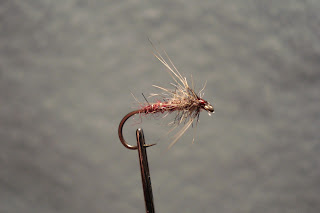Thread:
|
Yellow Pearsall’s gossamer silk
|
|
Abdomen:
|
Tying silk
|
|
Thorax:
|
Gray squirrel fur
|
|
Hackle:
|
Speckled hen hackle - here, Whiting Brahma
|
|
Early stoneflies like the February Red “are the earliest hatchings of the aquatic angling flies, and the first of the season to raise and cheer the lone trout,” Michael Theakston explains in his List of Flies (1843), “the harbingers of his better days; the warm sun draws out the firstlings of these hardy families; and they increase in numbers as the season advances, and the weather permits.” While Theakston does not cite a February Red, he does include a Red Brown as a dressing for February with “wings, from the landrail, or a slightly broken feather from a light freckled brown hen, or selected from the brown owl; orange or yellow silk for the body, with a few fibres of mohair or squirrel’s fur, at the breast, in imitation of the legs.” Theakston suggests two different colors for the body, but this comes as little surprise since every angling author seems to prefer a different color to imitate the same insect.
John Waller Hills
famously argued in his History of Fly Fishing (1921) that
the Orange
Patridge or Partridge and Orange, much after the fashion of Theakston, is
the classic dressing for the February Red, and he conjectures that Dame
Juliana Berners' gray wool-bodied Donne
Fly, a part of her twelve fly list in A treatyse of fysshynge
wyth an Angle (1496), was also originally dressed to match this
early stonefly hatch. Both James Chetham's Angler’s Vade Mecum (1681) and Charles Cotton’s additions to Izaak Walton’s Compleat Angler (1667) include a dressing for the Red-Brown (or Lesser Red-Brown) for February angling.
Cotton devotes more explanation to this fly than many: "Where the
Red-Brown of the last Month ends, another almost of the same colour begins
with this, saving that the dubbing of this must be of something a blacker
colour, and both of them warpt on with red silk; the dubbing that should make
this Flie, and that is the truest colour, is to be got of the black spot of a
Hogs ear: not that a black spot in any part of the Hog will not afford the
same colour; but that the hair in that place is by degrees softer, and more
fit for the purpose: his wing must be as the other, and this kills all this
Month, and is call’d the lesser Red-Brown." (The January dressing that
Cotton references and adjusts for February included very
specifically "the dubbing of the tail of a black long coated Cur,
such as they commonly makes muffs of; for the hair on the tail of such a Dog
dies, and turns to a red Brown.")
|
Likewise, Richard
and Charles Bowlker both include for the Red Fly in their editions of The
Art of Angling (1758, 1774), but theirs are winged wet flies. Alfred
Ronalds follows their cue in his Fly-Fisher’s Entomology (1836).
The Red Fly is the first on his list and is also dressed as a winged wet,
though he does, as usual, offer an alternative buzz or hackle dressing that uses a "copper
tinged dun hackle." The body he prescribes is much more complicated than
the simple silk recommended by other authors: "The dubbing is composed
of the dark red part of squirrel's fur, mixed with an equal
quantity of claret-coloured mohair, showing the most claret colour
at the tail of the fly. This is spun on, and warped with brown silk
thread."
|


